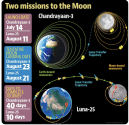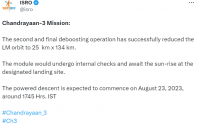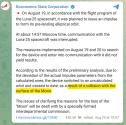You are using an out of date browser. It may not display this or other websites correctly.
You should upgrade or use an alternative browser.
You should upgrade or use an alternative browser.
NASA & World Space Exploration...News, Views, Photos & videos
- Thread starter bd popeye
- Start date
Why did it take weeks for India's lunar mission to reach the moon having launched back in July 14 vs Russia's launched in August 10? What's the technical differences between the two competing platforms?
Different trajectories.

The Indians used a phased loop to get more payload to the moon by using orbital dynamics tricks to get there for a given energy.
I am not 100% sure the diagram is entirely accurate as I thought the Russians had done a but of looping as well, but I could be mistaken.
Let's see if Venera-D works out for the Russians, assuming it gets launched. Mars 96, Phobos-Grunt and, now, Luna-25 have all been lost. I think that's all the missions the Russians have done past GEO recently.
Meanwhile, Chandrayaan-3 reached 25km X 134km orbit after the last deceleration before landing.

Worth to remember,
The original plan was
Enter 100km X 100km circular orbit after LM and Propulsion module separation.
Deceleration burn
Enter 30km X 100km pre-landing orbit
The actual is:
Entered 113km x 157km
Deceleration burn on 19th
Entered 25km X 134km pre-landing orbit

Worth to remember,
The original plan was
Enter 100km X 100km circular orbit after LM and Propulsion module separation.
Deceleration burn
Enter 30km X 100km pre-landing orbit
The actual is:
Entered 113km x 157km
Deceleration burn on 19th
Entered 25km X 134km pre-landing orbit
The "trick" is simple that I would not call it a trick. The earth and moon are two gravititional wells, to move a given mass from one to another consumes the same amount of chemical energy (equals to the delta of the potential energies of the two wells). If the fuel and impulse of the engines are the same, the difference in time of this transition is only determined by the thrust. A lower thrust engine has lower flow rate (burning the energe slower) and longer burning time for the same amount of fuel to reach the same velocity and DV/delta of energy, in other words longer time to accelerate and decelerate. However, it will also take longer distance, therefor the many loops both around the earth for acceleration and moon for deceleration.Different trajectories.
View attachment 117420
The Indians used a phased loop to get more payload to the moon by using orbital dynamics tricks to get there for a given energy.
I am not 100% sure the diagram is entirely accurate as I thought the Russians had done a but of looping as well, but I could be mistaken.
Let's see if Venera-D works out for the Russians, assuming it gets launched. Mars 96, Phobos-Grunt and, now, Luna-25 have all been lost. I think that's all the missions the Russians have done past GEO recently.
This "trick" has been played in many other situations such as GEO launches. In a more direct way, the carrier rocket will send the satellite directly to an orbit having the same energy as GEO, then the satellite will transit to the circular GEO by its own thrusters. In a less direct way, the satellite is placed in a GTO orbit which has lower enbergy than GEO, then the satellite will use its own fuel to reach GEO, this will consume the fuel of the satellite instead of the rocket, since the thruster of the satellite is much weaker than the rocket, it will take much longer time (and loops) to reach GEO.
Last edited:
I guess this is the reason of the discrepancy of the planned and actual moon orbit of Chndrayaan-3.
In the comment area of this report a month ago, ,

The initial earh orbit was planned to be 170km X 36500km, real orbit was 138km X 36306km. This means that the propulsion module had to use its fuel to do the job of the launcher in the earth bound loops. It is likely that the propulsion module had run out of fuel to further lower orbit in the moon bound loops before seperation with LM. So now the LM has to do the job of the propulsion module. This will squeeze the fuel margin for the landing phase.
As the commenter said, we will see if the LM has enough fuel for the actual landing.
In the comment area of this report a month ago, ,

The initial earh orbit was planned to be 170km X 36500km, real orbit was 138km X 36306km. This means that the propulsion module had to use its fuel to do the job of the launcher in the earth bound loops. It is likely that the propulsion module had run out of fuel to further lower orbit in the moon bound loops before seperation with LM. So now the LM has to do the job of the propulsion module. This will squeeze the fuel margin for the landing phase.
As the commenter said, we will see if the LM has enough fuel for the actual landing.
SpaceX conducted another static fire for booster 9 today.

